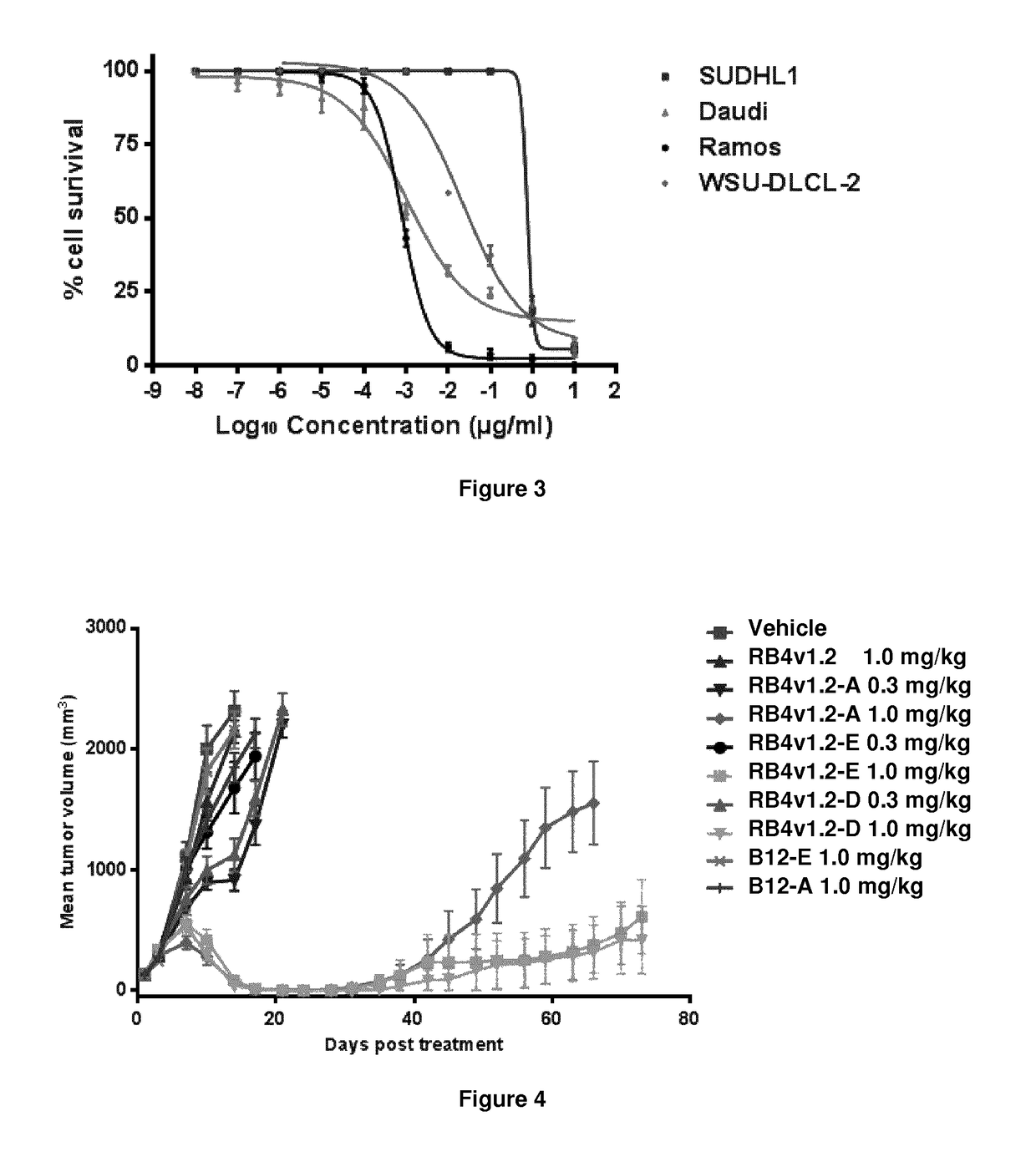Pyrrolobenzodiazepine-antibody conjugates
a technology of pyrrolobenzodiazepine and conjugates, which is applied in the direction of antinoxious agents, drug compositions, peptides, etc., can solve the problems of inacceptable levels of toxicity to normal cells, and achieve the effect of strengthening binding and reducing toxicity
- Summary
- Abstract
- Description
- Claims
- Application Information
AI Technical Summary
Benefits of technology
Problems solved by technology
Method used
Image
Examples
embodiments
[0534]Embodiments of the present invention include ConjA wherein the antibody is as defined above.
[0535]Embodiments of the present invention include ConjB wherein the antibody is as defined above.
[0536]Embodiments of the present invention include ConjC wherein the antibody is as defined above.
[0537]Embodiments of the present invention include ConjD wherein the antibody is as defined above.
[0538]Embodiments of the present invention include ConjE wherein the antibody is as defined above.
[0539]As mentioned above, some embodiments of the invention exclude ConjA, ConjB, ConjC, ConjD and ConjE.
Drug Loading
[0540]The drug loading is the average number of PBD drugs per antibody, e.g. antibody. Where the compounds of the invention are bound to cysteines, drug loading may range from 1 to 8 drugs (DL) per antibody, i.e. where 1, 2, 3, 4, 5, 6, 7, and 8 drug moieties are covalently attached to the antibody. Compositions of conjugates include collections of antibodies, conjugated with a range of ...
example 1
[0752]
(a) (S)-8-(3-(((S)-2-(4-aminophenyl)-7-methoxy-5,11-dioxo-10-((2-(trimethylsilyl)ethoxy)methyl)-5,10,11,11a-tetrahydro-1H-benzo[e]pyrrolo[1,2-a][1,4]diazepin-8-yl)oxy)propoxy)-7-methoxy-5,11-dioxo-10-((2-(trimethylsilyl)ethoxy)methyl)-5,10,11,11a-tetrahydro-1H-benzo[e]pyrrolo[1,2-a][1,4]diazepin-2-yl trifluoromethanesulfonate (13)
[0753]Pd(PPh3)4 (116.9 mg, 0.101 mmol) was added to a stirred mixture of the bis-enol triflate 12 (5.65 g, 5.06 mmol), 4-Aminophenylboronic acid pinacol ester (1 g, 4.56 mmol), Na2CO3 (2.46 g, 23.2 mmol), MeOH (37 mL), toluene (74 mL) and water (37 mL). The reaction mixture was allowed to stir at 30° C. under a nitrogen atmosphere for 24 hours after which time all the boronic ester has consumed. The reaction mixture was then evaporated to dryness before the residue was taken up in EtOAc (150 mL) and washed with H2O (2×100 mL), brine (150 mL), dried (MgSO4), filtered and evaporated under reduced pressure to provide the crude product. Purification by fl...
example 2
[0759]
(a) (R)-2-((R)-2-((((9H-fluoren-9-yl)methoxy)carbonyl)amino)-3-methylbutanamido) propanoic acid (20b)
[0760]HO-Ala-Val-H 20a (350 mg, 1.86 mmol) and Na2CO3 (493 mg, 4.65 mmol) were dissolved in distilled H2O (15 mL) and the mixture was cooled to 0° C. before dioxane (15 mL) was added (partial precipitation of the amino acid salt occurred). A solution of Fmoc-Cl (504 mg, 1.95 mmol) in dioxane (15 mL) was added dropwise with vigorous stirring over 10 minutes. The resulting mixture was stirred at 0° C. for 2 hours before the ice bath was removed and stirring was maintained for 16 hours. The solvent was removed by rotary evaporation under reduced pressure and the residue dissolved in water (150 mL). The pH was adjusted from 9 to 2 with 1N HCl and the aqueous layer was subsequently extracted with EtOAc (3×100 mL). The combined organics were washed with brine (100 mL), dried with MgSO4, filtered and the volatiles removed by rotary evaporation under reduced pressure to afford pure HO-...
PUM
 Login to View More
Login to View More Abstract
Description
Claims
Application Information
 Login to View More
Login to View More - R&D
- Intellectual Property
- Life Sciences
- Materials
- Tech Scout
- Unparalleled Data Quality
- Higher Quality Content
- 60% Fewer Hallucinations
Browse by: Latest US Patents, China's latest patents, Technical Efficacy Thesaurus, Application Domain, Technology Topic, Popular Technical Reports.
© 2025 PatSnap. All rights reserved.Legal|Privacy policy|Modern Slavery Act Transparency Statement|Sitemap|About US| Contact US: help@patsnap.com



